《Lesson28Whereisit》教学设计—冀教版
- 格式:docx
- 大小:11.94 KB
- 文档页数:50

(冀教版)五年级英语上册 Lesson 28 Where is it?教案设计2教学目标1.能够听懂、认读、运用生词:bedroom, bathroom, kitchen, living room2.能够运用所学知识来描述房屋和物品的位置3.能够活动中运用所学知识来制定指示单并进行指示4.通过小组合作学会互相协作练习口语交流技巧教学重难点1.生词学习和语音语调训练2.能够精准地使用介词在不同位置描述物品3.口语交际技巧的运用教学准备1.教师制作好指示单2.学生带上课本和文具,准备好互相协作3.教师准备黑板、书籍和学具教学过程导入(5分钟)1.询问学生是否还记得上一节课所学内容,并回顾生词的发音和读音2.通过小组互相协作让学生练习口语交流,以及描述物品和场景的基本句型训练新课讲解(15分钟)1.学生将学会新词汇并了解房屋和物品的位置,学习介词的应用,课堂互动让学生运用新学习的内容设计指示单2.针对生词和容易出现问题的部分进行规范性训练3.就学习中的细节进行问答互动,让学生加深对学习内容的了解细节问题:•如何运用不同的介词描述物品和位置•有哪些容易混淆的词汇语法讲解(10分钟)1.介绍方位介词的作用,并详细解释其使用方法2.分别列出方位介词在物品和场景中使用的例子,让学生通过练习锻炼掌握这些介词3.采取一种简单的场景来实际上手操作,让学生更好理解和掌握小组互动(20分钟)1.让学生按照指示单上的信息,在教室内活动,练习指导和指示的能力2.通过组内角色协作与合作,让学生在交流中锻炼口语交际技巧并理解不同场景下单词的使用含义总结(5分钟)1.通过学习成果的回顾,讲解本节课学习到的内容,整理和回顾上课中的重点内容2.以提问的形式,检验课堂效果,了解是否还有仍需加强的内容,及时总结课堂感受和体验家庭作业1.学生回家后根据所学知识,完成并提交指定作业练习2.设计一个新的指示单,然后在家试着自己完成一下教学反思1.课程前讲课设计器的方法应该更加细致2.反思多个指导点,学生理解和掌握难度更大(少量指导点易于学生掌握)。
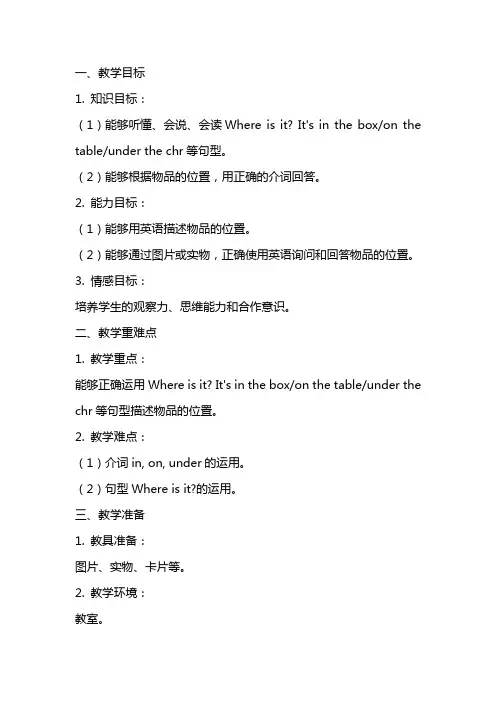
1. 知识目标:(1)能够听懂、会说、会读Where is it? It's in the box/on the table/under the chr等句型。
(2)能够根据物品的位置,用正确的介词回答。
2. 能力目标:(1)能够用英语描述物品的位置。
(2)能够通过图片或实物,正确使用英语询问和回答物品的位置。
3. 情感目标:培养学生的观察力、思维能力和合作意识。
二、教学重难点1. 教学重点:能够正确运用Where is it? It's in the box/on the table/under the chr等句型描述物品的位置。
2. 教学难点:(1)介词in, on, under的运用。
(2)句型Where is it?的运用。
三、教学准备1. 教具准备:图片、实物、卡片等。
2. 教学环境:教室。
1. 热身(5分钟)(1)跟唱歌曲“Where is my car?”。
(2)老师出示各种物品,学生用中文回答物品的位置。
2. 导入(10分钟)(1)老师出示一张图片,引导学生用中文描述图片中物品的位置。
(2)学生分组,每组选一张图片,用中文描述图片中物品的位置。
3. 呈现(10分钟)(1)老师出示一张图片,用英语描述图片中物品的位置,如:“Where is it? It's in the box.”。
(2)老师再出示一张图片,引导学生用英语描述图片中物品的位置。
4. 操练(10分钟)(1)老师分组,每组选一张图片,用英语描述图片中物品的位置。
(2)学生分组,每组选一张图片,用英语描述图片中物品的位置。
5. 巩固(10分钟)(1)老师出示各种物品,学生用英语描述物品的位置。
(2)学生互相提问,用英语描述物品的位置。
6. 拓展(10分钟)(1)老师出示一张地图,引导学生用英语描述地图上某个地点的位置。
(2)学生分组,每组选一个地点,用英语描述地点的位置。
7. 总结(5分钟)老师引导学生用中文总结本节课所学内容。

四年级下册《Where is it?》优秀教案第一章:课程简介1.1 教学目标让学生能够理解并运用疑问词“where”询问物品的位置。
让学生能够用简单的句子描述物品的位置。
培养学生的观察能力和思维能力。
1.2 教学内容学习疑问词“where”的用法。
学习并掌握表示位置的词汇:on, in, under, next to等。
通过观察和描述,练习用英语表达物品的位置。
第二章:教学方法2.1 直观法使用图片、实物等直观教具,帮助学生理解和记忆。
通过观察和描述,培养学生的观察能力和思维能力。
2.2 情境教学法创设情境,让学生在实际情境中运用英语。
通过角色扮演、模拟情境等,增加学生的语言实践机会。
2.3 任务型教学法设计各种任务,让学生在完成任务的过程中运用英语。
通过小组讨论、合作完成任务等,培养学生的合作能力和沟通能力。
第三章:教学步骤3.1 热身活动(5分钟)利用歌曲或游戏,引导学生复习已学的疑问词和表示位置的词汇。
3.2 新课导入(10分钟)利用图片或实物,引入新课主题,引导学生用英语描述物品的位置。
通过问答方式,引导学生学习并理解疑问词“where”的用法。
3.3 课堂活动(15分钟)分组进行角色扮演,让学生在实际情境中运用英语描述物品的位置。
设计任务,让学生分组合作,完成任务。
3.4 巩固练习(10分钟)提供一些图片或实物,让学生用英语描述它们的位置。
进行小组竞赛,看哪个小组描述得最快最准确。
第四章:作业布置让学生回家后,找一些物品,用英语描述它们的位置,并拍照或画图记录下来。
让学生回家后,与家长一起进行英语对话,用英语描述家庭物品的位置。
第五章:评价与反思5.1 课堂评价在课堂上,观察学生的参与程度、语言表达能力和合作能力。
通过问答和任务完成情况,评估学生对疑问词“where”和表示位置的词汇的掌握程度。
5.2 作业评价评估学生的作业完成情况,包括语言表达准确性和创造性。
鼓励学生在家与家长进行英语对话,观察学生的语言运用能力。
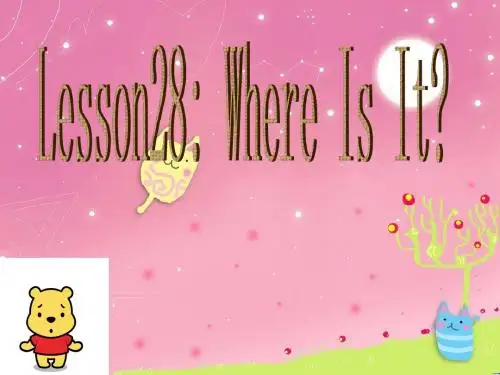
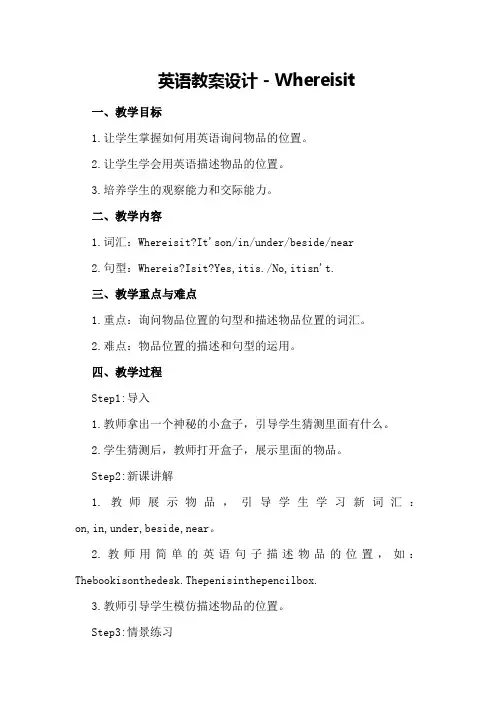
英语教案设计-Whereisit一、教学目标1.让学生掌握如何用英语询问物品的位置。
2.让学生学会用英语描述物品的位置。
3.培养学生的观察能力和交际能力。
二、教学内容1.词汇:Whereisit?It'son/in/under/beside/near2.句型:Whereis?Isit?Yes,itis./No,itisn't.三、教学重点与难点1.重点:询问物品位置的句型和描述物品位置的词汇。
2.难点:物品位置的描述和句型的运用。
四、教学过程Step1:导入1.教师拿出一个神秘的小盒子,引导学生猜测里面有什么。
2.学生猜测后,教师打开盒子,展示里面的物品。
Step2:新课讲解1.教师展示物品,引导学生学习新词汇:on,in,under,beside,near。
2.教师用简单的英语句子描述物品的位置,如:Thebookisonthedesk.Thepenisinthepencilbox.3.教师引导学生模仿描述物品的位置。
Step3:情景练习1.教师将教室里的物品摆放在不同的位置,让学生用英语描述物品的位置。
2.学生分组进行练习,互相提问并回答。
Step4:小组活动1.教师将学生分成小组,每组一个盒子,盒子里有不同物品。
2.学生用英语描述盒子里的物品位置,其他组员猜测物品是什么。
Step5:游戏环节1.游戏名称:猜猜我在哪儿2.游戏规则:教师将一个物品藏在教室的某个地方,学生用英语询问物品的位置,教师回答Yes或No,直到学生找到物品为止。
2.布置作业:用英语描述家里的物品位置,并让家长签字。
五、课后反思1.本节课通过生动的情景和有趣的游戏,让学生在轻松愉快的氛围中学习英语。
2.学生在练习描述物品位置的过程中,提高了观察能力和交际能力。
3.教师应及时关注学生的学习情况,给予个别辅导,确保每个学生都能掌握所学内容。
六、教学评价1.课堂表现:观察学生在课堂上的参与程度和表现,了解学生的学习兴趣和积极性。
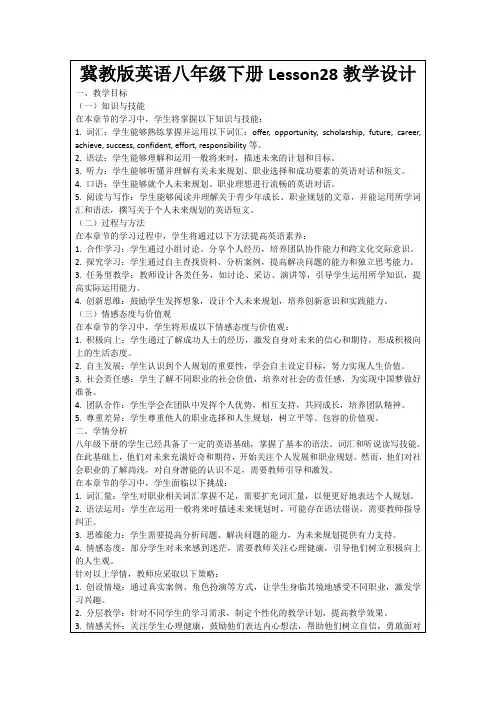
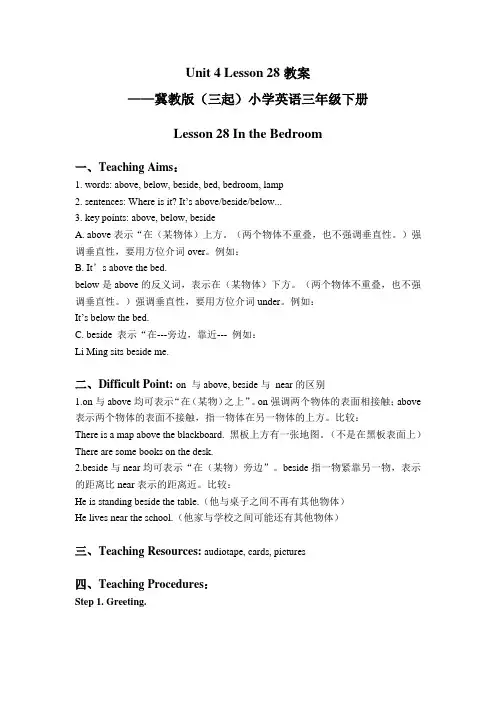
Unit 4 Lesson 28教案——冀教版(三起)小学英语三年级下册Lesson 28 In the Bedroom一、Teaching Aims:1. words: above, below, beside, bed, bedroom, lamp2. sentences: Where is it? It’s above/beside/below...3. key points: above, below, besideA. above表示“在(某物体)上方。
(两个物体不重叠,也不强调垂直性。
)强调垂直性,要用方位介词over。
例如:B. It’s above the bed.below是above的反义词,表示在(某物体)下方。
(两个物体不重叠,也不强调垂直性。
)强调垂直性,要用方位介词under。
例如:It’s below the bed.C. beside 表示“在---旁边,靠近--- 例如:Li Ming sits beside me.二、Difficult Point: on 与above, beside与near的区别1.on与above均可表示“在(某物)之上”。
on强调两个物体的表面相接触;above 表示两个物体的表面不接触,指一物体在另一物体的上方。
比较:There is a map above the blackboard. 黑板上方有一张地图。
(不是在黑板表面上)There are some books on the desk.2.beside与near均可表示“在(某物)旁边”。
beside指一物紧靠另一物,表示的距离比near表示的距离近。
比较:He is standing beside the table.(他与桌子之间不再有其他物体)He lives near the school.(他家与学校之间可能还有其他物体)三、Teaching Resources: audiotape, cards, pictures四、Teaching Procedures:Step 1. Greeting.Step 2. Review Lesson 27What is he/she doing?He/She is sitting.What are they doing?They are making dumplings.Step 3. L28 N1 What is it?1. Presentation(Show pictures to the students.)Teach the new words:bedroom, bed, lampWrite the new words on the blackboard.2. Play the tape3. Practice in pairsWhat’s this?What colour is it?Is this a or a?Step 4. N2 Where is it?1. PresentationDraw on the blackboard to introduce the new words above, below and beside.Write the new words and sentences on the blackboard.Explain the difference between above and on and the difference between below and under.2. Practice(1) Play the audiotape. Listen and answer.Where is the picture?Where are the shoes?Where is the lamp?(2)Draw. Ask the students to draw the pictures of their own bedrooms and describe them.(3)Talk about the picture.The picture is above the bed.The bed is below the picture.Step 5. Homework.1. Finish off the activity book.2. Recite Lesson 373. Preview Lesson 38。
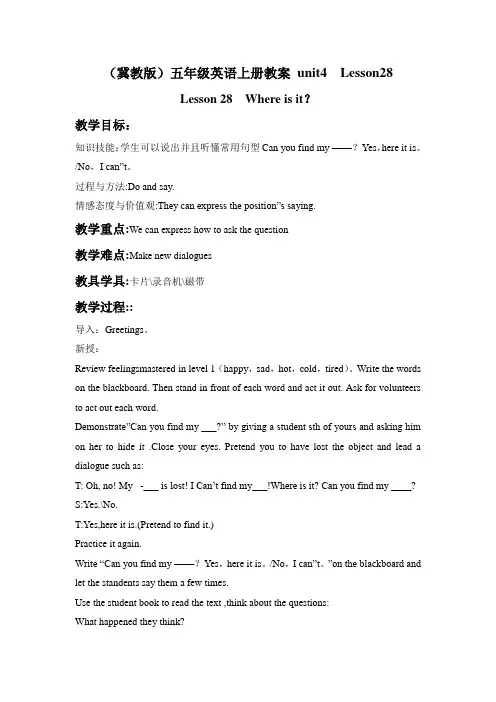
(冀教版)五年级英语上册教案unit4 Lesson28Lesson 28 Where is it?教学目标:知识技能:学生可以说出并且听懂常用句型Can you find my ——?Yes,here it is。
/No,I can”t。
过程与方法:Do and say.情感态度与价值观:They can express the position”s saying.教学重点:We can express how to ask the question教学难点:Make new dialogues教具学具:卡片\录音机\磁带教学过程::导入:Greetings。
新授:Review feelingsmastered in level 1(happy,sad,hot,cold,tired)。
Write the words on the blackboard. Then stand in front of each word and act it out. Ask for volunteers to act out each word.Demonstrate”Can you find my ___?” by giving a student sth of yours and asking him on her to hide it .Close your eyes. Pretend you to have lost the object and lead a dialogue such as:T: Oh, no! My _-___ is lost! I Can’t find my___!Where is it? Can you find my ____? S:Yes.\No.T:Yes,here it is.(Pretend to find it.)Practice it again.Write “Can you find my ——?Yes,here it is。
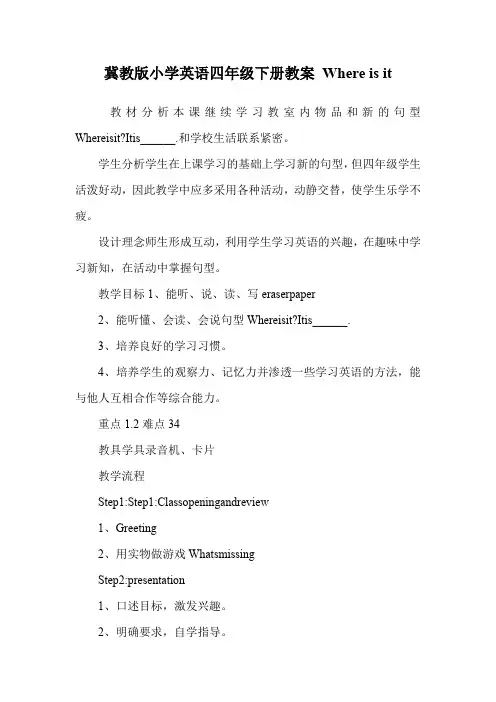
冀教版小学英语四年级下册教案Where is it教材分析本课继续学习教室内物品和新的句型Whereisit?Itis______.和学校生活联系紧密。
学生分析学生在上课学习的基础上学习新的句型,但四年级学生活泼好动,因此教学中应多采用各种活动,动静交替,使学生乐学不疲。
设计理念师生形成互动,利用学生学习英语的兴趣,在趣味中学习新知,在活动中掌握句型。
教学目标1、能听、说、读、写eraserpaper2、能听懂、会读、会说句型Whereisit?Itis______.3、培养良好的学习习惯。
4、培养学生的观察力、记忆力并渗透一些学习英语的方法,能与他人互相合作等综合能力。
重点1.2难点34教具学具录音机、卡片教学流程Step1:Step1:Classopeningandreview1、Greeting2、用实物做游戏WhatsmissingStep2:presentation1、口述目标,激发兴趣。
2、明确要求,自学指导。
A:呈现单词:eraserpaper利用实物学习新的指示,会者充当小老师领读,学生跟读,利用录音机纠正学生错误的发音,使学生注意单词声音的高低变化,并让学生利用词卡掌握所学单词。
B:学习句型Whereisit?Itis______.1、用教室物品引入句型,引导学生说出句子。
2、互助互学,检查点拨。
①利用词卡袋演示如何在it?Itis______。
进行单词替换,找两名学生,给其中一个学生两件物品如铅笔和椅子,并以任何一种相对位置一名学生问Whereis?另外一名学生指着单词做出相应的回答:Its_______.②用教室里的物品,特别是粉笔、橡皮擦、纸张、铅笔盒等做Hideit游戏。
Step3:Classclosing做Whisper游戏结束课堂激发学生兴趣,引出本课所学。
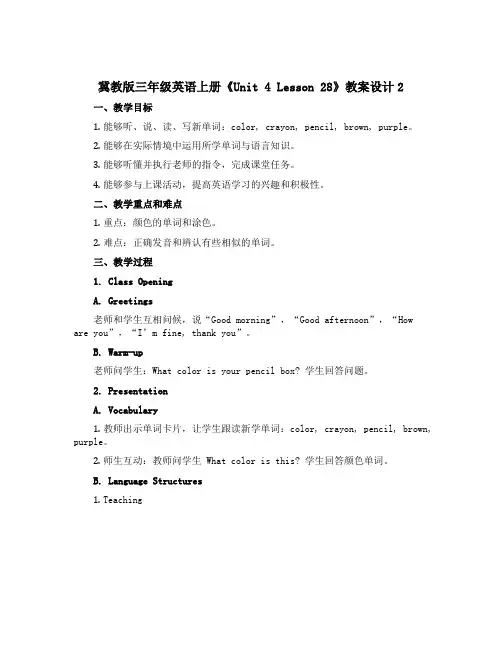
冀教版三年级英语上册《Unit 4 Lesson 28》教案设计2
一、教学目标
1.能够听、说、读、写新单词:color, crayon, pencil, brown, purple。
2.能够在实际情境中运用所学单词与语言知识。
3.能够听懂并执行老师的指令,完成课堂任务。
4.能够参与上课活动,提高英语学习的兴趣和积极性。
二、教学重点和难点
1.重点:颜色的单词和涂色。
2.难点:正确发音和辨认有些相似的单词。
三、教学过程
1. Class Opening
A. Greetings
老师和学生互相问候,说“Good morning”,“Good afternoon”,“How
are you”,“I’m fine, thank you”。
B. Warm-up
老师问学生:What color is your pencil box? 学生回答问题。
2. Presentation
A. Vocabulary
1.教师出示单词卡片,让学生跟读新学单词:color, crayon, pencil, brown, purple。
2.师生互动:教师问学生 What color is this? 学生回答颜色单词。
B. Language Structures
1.Teaching。
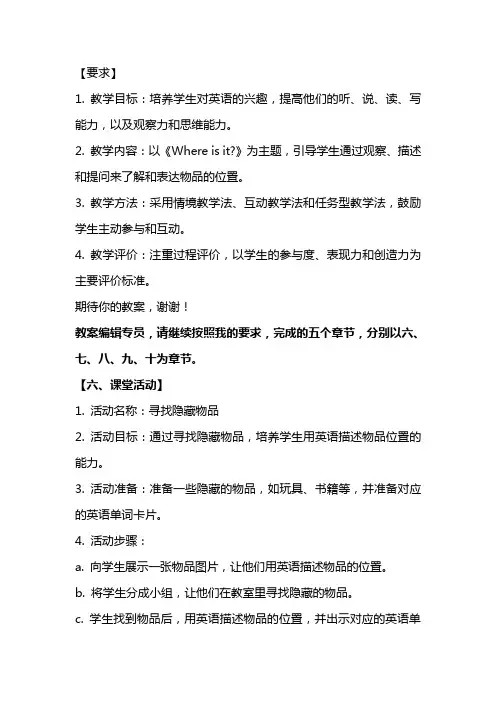
1. 教学目标:培养学生对英语的兴趣,提高他们的听、说、读、写能力,以及观察力和思维能力。
2. 教学内容:以《Where is it?》为主题,引导学生通过观察、描述和提问来了解和表达物品的位置。
3. 教学方法:采用情境教学法、互动教学法和任务型教学法,鼓励学生主动参与和互动。
4. 教学评价:注重过程评价,以学生的参与度、表现力和创造力为主要评价标准。
期待你的教案,谢谢!教案编辑专员,请继续按照我的要求,完成的五个章节,分别以六、七、八、九、十为章节。
【六、课堂活动】1. 活动名称:寻找隐藏物品2. 活动目标:通过寻找隐藏物品,培养学生用英语描述物品位置的能力。
3. 活动准备:准备一些隐藏的物品,如玩具、书籍等,并准备对应的英语单词卡片。
4. 活动步骤:a. 向学生展示一张物品图片,让他们用英语描述物品的位置。
b. 将学生分成小组,让他们在教室里寻找隐藏的物品。
c. 学生找到物品后,用英语描述物品的位置,并出示对应的英语单d. 其他学生听描述,找出物品的位置。
5. 活动评价:观察学生在寻找和描述过程中的表现,评价他们的听、说、观察和思维能力。
【七、课堂游戏】1. 活动名称:位置猜谜游戏2. 活动目标:通过猜谜游戏,提高学生用英语描述位置的能力。
3. 活动准备:准备一些关于位置的谜语。
4. 活动步骤:a. 向学生展示一个谜语,让他们用英语描述谜底的位置。
b. 其他学生听描述,猜出谜底。
c. 学生轮流展示谜语,其他学生猜谜底。
5. 活动评价:观察学生在游戏中的表现,评价他们的听、说、观察和思维能力。
【八、课堂练习】1. 活动名称:位置描述练习2. 活动目标:通过练习,巩固学生用英语描述位置的能力。
3. 活动准备:准备一些关于位置的图片。
4. 活动步骤:a. 向学生展示一张图片,让他们用英语描述图片中物品的位置。
b. 学生互相交换图片,互相描述物品的位置。
5. 活动评价:评价学生的描述准确性和语言表达能力。
Lesson 28 Where is it?——冀教版小学英语第5册一.教材分析(一)本课地位本课属于该册书第四单元中承上启下的一课,它以Li Ming 和Jenny帮糊涂的Danny找东西的趣味小故事为背景,复习巩固了前几课学习的衣服类的名词以及有关can 的句型,并延伸出新知识,也为以后的学习做铺垫。
因此,本课在书中有着重要的地位。
(二)教学目标:1.认知目标:学生能够认读、拼写新单词:key, pyjamas.学生能够掌握句型:My key is lost. / I can’t find my key. / Can you find my key?2.能力目标:学生能运用上述句型进行询问和表述。
3.情感目标:使学生养成仔细认真,善于整理自己的东西的好习惯。
(三)教学重难点及突破:1.重点:新句型My key is lost. / I can’t find my key. / Can you find my key?2.难点:能运用所学句型再现本课故事情节,并能加以表演。
3.突破方法:在本课中添加一些有趣的游戏活动,如“what’s missing”, 这样既可以自然地引出本课重点句型,还能起到巩固练习的作用,同时还调动了学生学习的积极性。
二.学情分析五年级学生已处于小学高年级阶段,但仍然活泼好动,喜欢直观形象思维,对游戏、竞赛、画画有浓厚的兴趣。
大部分学生已经有了不错的英语基础,但也有少数学生在学习英语中遇到困难,导致学习兴趣不强。
因此,本课旨在让学生们在玩玩、做做、说说中学习英语,不断激发学生的学习兴趣,引导学生端正学习态度,掌握良好的学习方法,培养学生良好的学习习惯。
三. 教法与教具1.教法:直接法,全身反应法,自然教学法等。
2.教具:黑板,多媒体,单词卡片等。
四. 教学程序Step one : Warming up1.Greeting.(设计意图:教师与学生热情、亲切的问候,为学生提供了一个轻松、祥和的学习环境。
Lesson 28:where is it课型新授课课时2-1教学目标知识与技能:正确的认读单词suitcase pyjamas;掌握词组 get ready for;掌握下列句子:a. What is the matter? I can’t find___.过程与方法:看图片理解单词意思,通过俩人、小组对话,掌握Where is it?的问答。
情感、态度和价值观:培养学生学会互助交流的能力。
重点难点重点:单词及词组的学习。
难点:熟练地应用句子。
学法指导学生活动教具学具卡片,光盘通案个案自主参与,复习导入:复习提问where is_____?句型.二、创设情景,引入新知:Part 1: 教师做动作,找自己的书,用英语问where is my book?让学生回答,要求学生尽量用英语。
1.教师组织学生模拟找东西的场景:要求每两位同学一组,利用书上的实物单词自己组织内容,不会的记下。
2.操练对话:A: I can’t find my _____?B: Can you find my_____ ?A: Yes,I can. Here it is!B: Thank you!3.学生根据自己设计的内容表演对话:教师要及时表扬表现好的组,并纠正学生的错误。
4.学生看课文的光盘,听课文录音。
小结:Can you find___?的用法。
三、巩固练习:1、读课文。
2、小组讨论回答问题(根据课文回答提问):What’s the matter to Danny?Does it find the key\pyjamas\teddy bear ?Who help to find them?四、课堂总结今天你都学会了什么?有什么收获?五、作业:熟练运用Can you find __?课堂检测填空:1 I can’t find __________bike._______bike is lost.2 _______can’t find your book._________book is lost.3 She can’t find her睡衣Her 睡衣 are lost.4 ____can’t find ____key.His key is lost.教学反思课题Lesson 28: where is it课型新授课课时2-2教学目标知识与技能:掌握Where is________?的运用方法。
《Lesson 28Where is it?》教学设计—冀教版教学目标:1、知识技能:学生可以说出并且听懂常用句型Can you find my ——?Yes,here it is。
/No,I can“t。
2、过程与方法:Do and say.3、情感态度与价值观:They can express the position”s saying.教学重点:We can express how to ask the question 教学难点:Make new dialogues教具学具:卡片\录音机\磁带教学过程::1、导入:Greetings。
2、新授:(1)Review feelingsmastered in level 1(happy,sad,hot,cold,tired)。
Write the words on the blackboard. Then stand in front of each word and act it out. Ask for volunteers to act out each word.(2)Demonstrate“Can you find my ___?”by giving a student sth of yours and asking him on her to hideit .Close your eyes. Pretend you to have lost the object and lead a dialogue such as:T: Oh, no! My _-___ is lost! I Can't find my___!Where is it? Can you find my____?S:Yes.\No.T:Yes,here it is.(Pretend to find it.)(3) Practice it again.(4) Write “Can you find my ——?Yes,here it is。
/No,I can”t。
“on the blackboard and let thestandents say them a few times.(5) Use the student book to read thetext ,think about the questions:What happened they think?What is Danny wearing? Why?(6) Practice and play”Can you find it?“(7) Give them enough time to practice thedialogue and work in pairs.(8) Questions: My _-___ is lost!I Can't find my___!Where is it?Can you find my ____?Yes,here it is。
/No,I can”t。
(9) Let them act the dialogue and then check out.3、小结:Let the students say what they have learned from the text.4、作业:Write down the sentences on the pieces of the paper.板书设计: Can you find my ____?Yes,here it is。
/No,I can“t课后反思:教学目标:1、知识技能:学生可以说出并且听懂常用句型Can you find my ——?Yes,here it is。
/No,I can“t。
2、过程与方法:Do and say.3、情感态度与价值观:They can express the position”ssaying.教学重点:We can express how to ask the question 教学难点:Make new dialogues教具学具:卡片\录音机\磁带教学过程::1、导入:Greetings。
2、新授:(1)Review feelingsmastered in level 1(happy,sad,hot,cold,tired)。
Write the words on the blackboard. Then stand in front of each word and act it out. Ask for volunteers to act out each word.(2)Demonstrate“Can you find my ___?”by giving a student sth of yours and asking him on her to hideit .Close your eyes. Pretend you to have lost the object andlead a dialogue such as:T: Oh, no! My _-___ is lost! I Can't find my___!Where is it? Can you find my____?S:Yes.\No.T:Yes,here it is.(Pretend to find it.)(3) Practice it again.(4) Write “Can you find my ——?Yes,here it is。
/No,I can”t。
“on the blackboard and let the standents say them a few times.(5) Use the student book to read the text ,think about the questions:What happened they think?What is Danny wearing? Why?(6) Practice and play”Can you find it?“(7) Give them enough time to practice the dialogue and work in pairs.(8) Questions: My _-___ is lost!I Can't find my___!Where is it?Can you find my ____?Yes,here it is。
/No,I can”t。
(9) Let them act the dialogue and then check out.3、小结:Let the students say what they have learned from the text.4、作业:Write down the sentences on the pieces of the paper.板书设计: Can you find my ____?Yes,here it is。
/No,I can“t课后反思:教学目标:1、知识技能:学生可以说出并且听懂常用句型Can you find my ——?Yes,here it is。
/No,I can“t。
2、过程与方法:Do and say.3、情感态度与价值观:They can express the position”ssaying.教学重点:We can express how to ask the question 教学难点:Make new dialogues教具学具:卡片\录音机\磁带教学过程::1、导入:Greetings。
2、新授:(1)Review feelingsmastered in level 1(happy,sad,hot,cold,tired)。
Write the words on the blackboard. Then stand in front of each word and act it out. Ask for volunteers to act out each word.(2)Demonstrate“Can you find my ___?”by giving a student sth of yours and asking him on her to hideit .Close your eyes. Pretend you to have lost the object andlead a dialogue such as:T: Oh, no! My _-___ is lost! I Can't find my___!Where is it? Can you find my____?S:Yes.\No.T:Yes,here it is.(Pretend to find it.)(3) Practice it again.(4) Write “Can you find my ——?Yes,here it is。
/No,I can”t。
“on the blackboard and let the standents say them a few times.(5) Use the student book to read the text ,think about the questions:What happened they think?What is Danny wearing? Why?(6) Practice and play”Can you find it?“(7) Give them enough time to practice the dialogue and work in pairs.(8) Questions: My _-___ is lost!I Can't find my___!Where is it?Can you find my ____?Yes,here it is。
/No,I can”t。
(9) Let them act the dialogue and then check out.3、小结:Let the students say what they have learned from the text.4、作业:Write down the sentences on the pieces of the paper.板书设计: Can you find my ____?Yes,here it is。
/No,I can“t课后反思:教学目标:1、知识技能:学生可以说出并且听懂常用句型Can you find my ——?Yes,here it is。